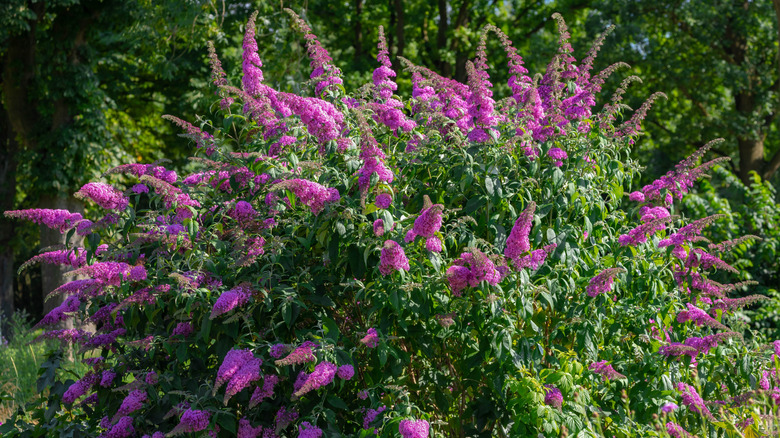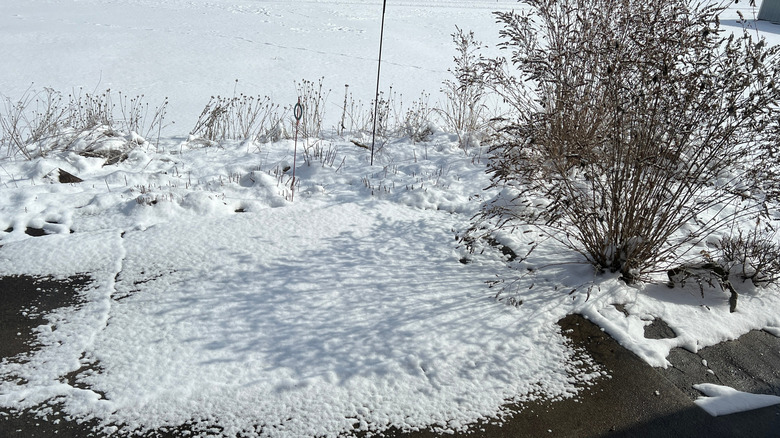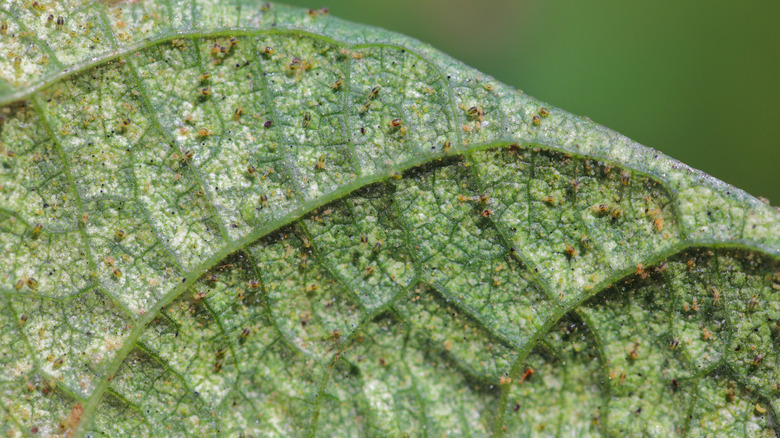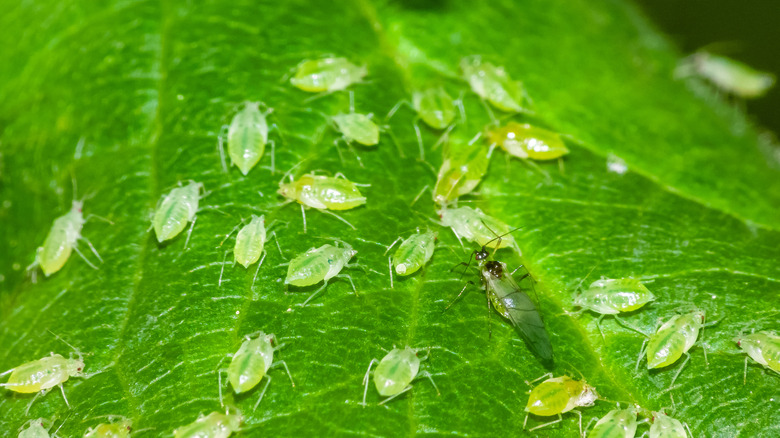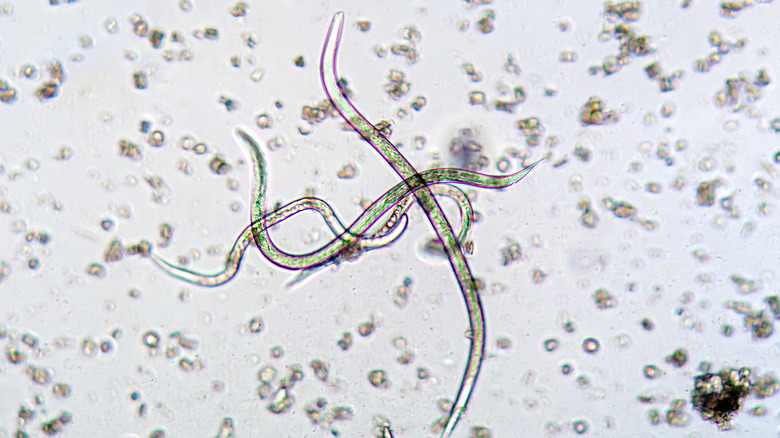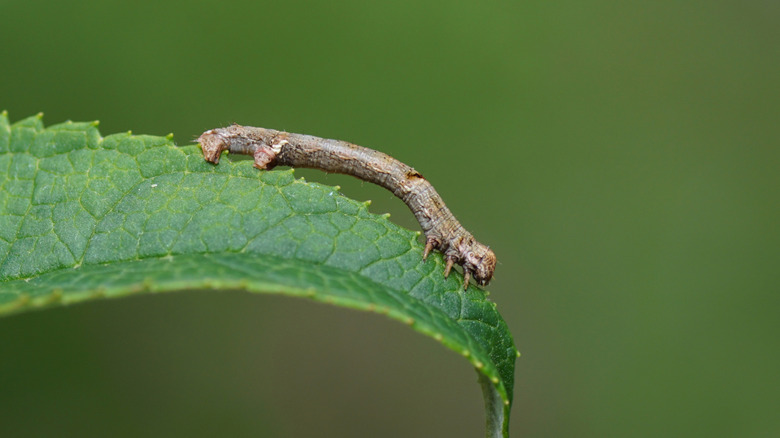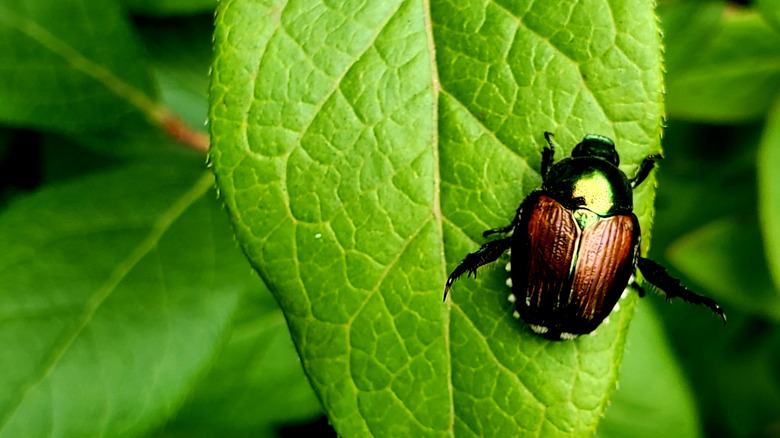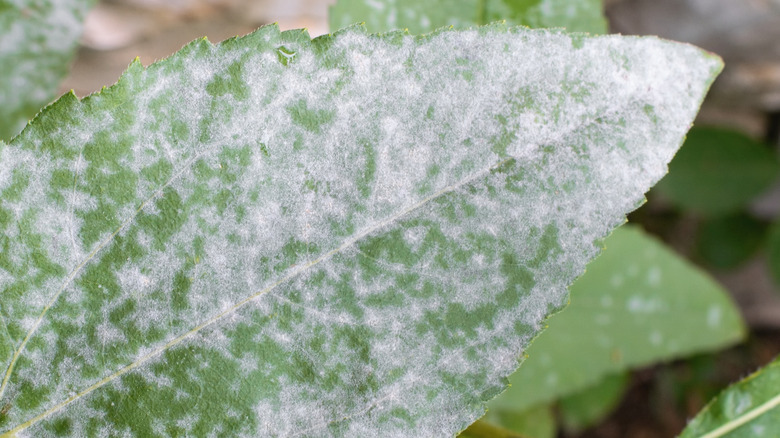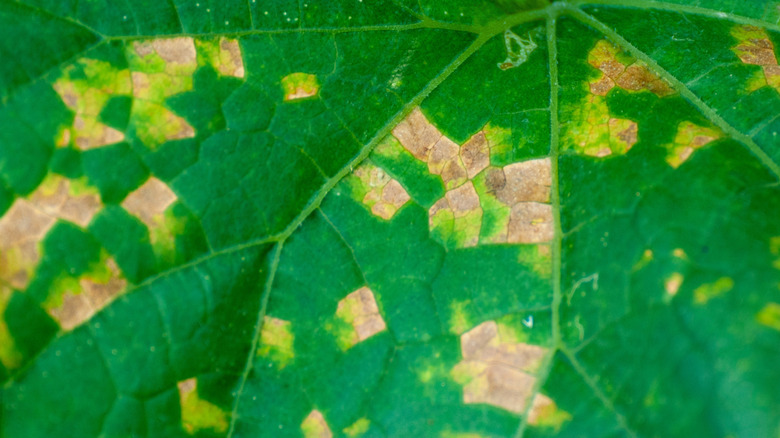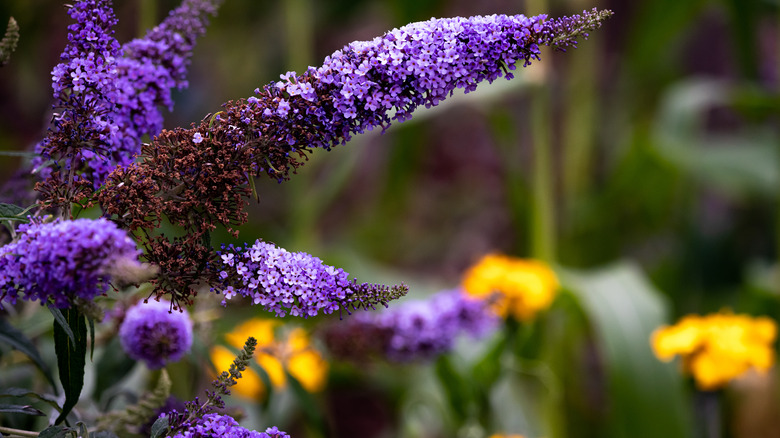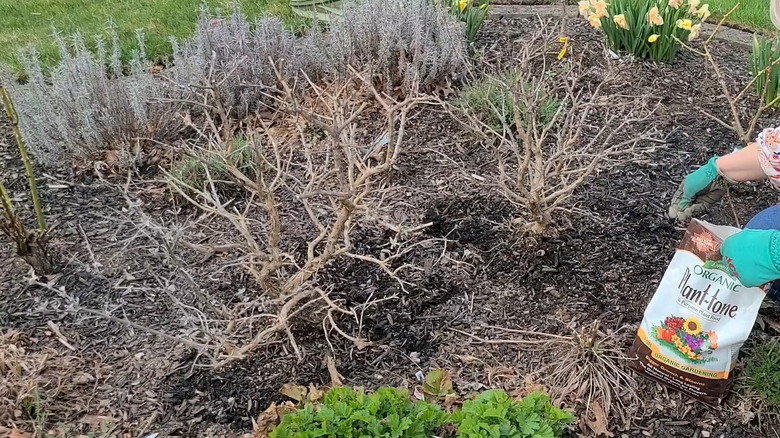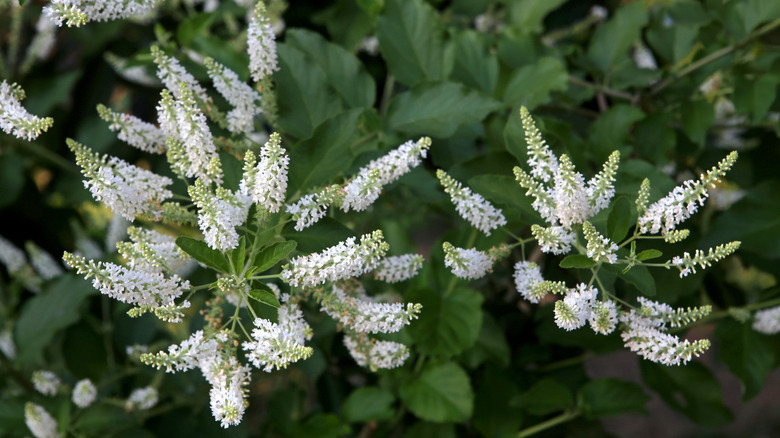Common Butterfly Bush Problems And Diseases You Shouldn't Ignore
We may receive a commission on purchases made from links.
Butterfly bushes (Buddleja davidii) are a garden staple for a reason: Not only are they ginormous — getting up to 12 feet high — and gorgeous, but they're magnets for pollinators and are easy to care for. Don't let their seemingly carefree nature fool you, though, because these plants are prone to a range of common problems that, if ignored, can quickly transform a thriving bush into heartbreak.
Various pests can strip a bush bare, and fungal diseases can leave leaves looking as though they've been through a shredder. If you plan to plant these, then it's crucial to know what to look for and how to address a problem before it becomes a devastating issue. Here are the most common problems gardeners report dealing with when caring for a butterfly bush and the ways you can combat them, so your plant stays happy and healthy all season long.
Frost damage can make it hard for butterfly bushes to bounce back
Butterfly bushes, while generally considered hardy, are susceptible to frost damage, especially in colder climates or during late spring frosts. When exposed to freezing temperatures, new growth and developing buds can be severely damaged, appearing as blackened or wilted leaves and stems, and, in severe cases, the whole plant may die back to the ground. If you're unlucky enough to get multiple frosts, your butterfly bush could withstand the low temperatures, but may end up in a weakened state, making it more vulnerable to diseases and pests, as well as delaying or preventing blooming. Butterfly bushes growing in USDA Zone 4 or below are particularly susceptible to frost damage.
If your butterfly bush develops frost damage, its recovery will depend on the severity of the freeze and the bush's overall health. To help it recover, wait until the risk of further frosty nights has passed, then prune away damaged growth to prevent disease and encourage new growth. Mulch around the base of the plant to insulate the roots. Ensure the plant receives water and nutrients to support recovery. If a late spring frost is predicted, cover the bush with frost cloth or burlap. One more thing: Avoid pruning your butterfly bush too much in the fall, as old and excess growth can actually help protect it. Instead, the best time to cut back a butterfly bush is during the early spring once all signs of frost are gone. With proper care, butterfly bushes can recover from frost damage, although you should expect it to be a little slow to bounce back to its full, bushy self.
Spider mites can decimate a butterfly bush during hot, dry periods
Spider mites can wreak absolute havoc on butterfly bushes, especially during hot, dry spells. These minuscule pests, barely visible to the naked eye, feed on the plant's sap, causing leaves to become speckled, yellowed, and eventually bronzed. Heavy infestations can lead to leaf drop, leaving the bush looking thin and stressed. To make the issue even more frustrating, the dry conditions that often come along with hot weather creates an ideal environment for spider mites to thrive and reproduce rapidly, allowing them to quickly decimate a butterfly bush if left unchecked.
If you have spider mites throwing a rager on your butterfly bush, it's time to crash the party. There are lots of ways to get rid of spider mites, but start by shooting a strong jet of water from your garden hose to send many of those little freeloaders packing from the undersides of leaves. For more persistent squatters, insecticidal soap or neem oil can be effective, but you might need to use it a few times if the colony has exploded. There's also the option of introducing the spider mites' natural predators, like ladybugs or predatory mites, into your garden to help control the population. Keeping things moist around the plant, especially during those super hot summer months, makes it less inviting for these tiny squatters. And finally, just giving your bush a good once-over now and then will help you spot these guys before they turn your prized plant into a mite-infested wasteland.
Aphids and their honeydew secretions can make butterfly bush vulnerable to fungal infections
Aphids, those tiny sap-sucking nuisances, can turn a healthy butterfly bush into a sticky, fungal breeding ground. These little buggers feed on the plant's sap, excreting a sugary substance called honeydew that not only makes the leaves and stems sticky, but it also attracts sooty mold. Sooty mold is a big problem for butterfly bushes because it can block sunlight, hinder photosynthesis, and weaken the plant, making it more susceptible to other diseases and pests.
If you suspect aphids have found your butterfly bush, but aren't sure, first check for ant activity; ants often protect aphids in exchange for honeydew, so controlling ants can help control aphids. Gently wipe off any visible honeydew with a damp cloth to remove the sticky residue and prevent sooty mold from taking hold. For aphid removal, start the same way you would with spider mites: Hit them with a jet of water from the garden hose. Using a targeted spray of insecticidal soap is also effective, just focus on the undersides of leaves where they tend to congregate. A diluted neem oil solution can also disrupt their feeding and reproduction. If sooty mold has already established itself, address the aphid infestation first, then gently wash or remove the affected leaves. Maintaining good airflow around the plant can also discourage both aphids and mold. And remember, regular checks will help you catch these sap-suckers before they throw a full-blown fungal outbreak.
Nematodes cause severe tissue damage to butterfly bushes, particularly in the south
If you're gardening in the south, you might find that the microscopic menace known as nematodes can cause some serious damage to your butterfly bushes. These tiny, soil-dwelling parasites attack the plant's roots, causing galls, lesions, and overall tissue damage. Affected plants often exhibit stunted growth, yellowing leaves, and a general decline in their hardiness. Because these pests attack the roots, the damage is often hidden until it's quite severe, making them a real sneaky problem.
So, why are southern gardeners more likely to see nematodes than those in the northern climates? It's due to the soil conditions; nematodes thrive in warm, sandy soils, which are found in the coastal sand plains. Unfortunately, once nematodes have taken hold, they're tough to get rid of completely, so prevention is key. Regardless of where you live and garden, incorporating organic matter, such as manure or peat, into the soil can help improve its structure and make it less hospitable to nematodes. If you suspect a severe infestation, try utilizing soil solarization, a process of heating the soil with clear plastic — this can help kill nematodes. It's a bit of a drastic measure, but soil solarization can help keep away both pests and weeds, so it could be a useful approach. Finally, of course, keeping your butterfly bush healthy and strong can help it better withstand nematode attacks.
Buddleja budworm infestations can kill entire butterfly bushes
Those seemingly innocent buds on your butterfly bush can sometimes harbor a destructive secret: buddleja budworms. These sneaky caterpillars are the larvae of the Buddleia leaf-eating moth (Pyramidobela angelarum) and will bore into the buds and developing flowers, feeding on their delicate tissues. If you're unlucky enough to get a severe infestation, they can completely destroy the flower display and even kill off entire branches or the whole bush. It's like having tiny, hidden saboteurs taking down your plant from the inside out.
You might first notice small holes in the buds or find the caterpillars themselves, which are usually greenish or brownish, tucked away inside. Handpicking the caterpillars can be effective for small infestations, but you'll have to be diligent about checking the buds regularly. For larger infestations, consider using Bacillus thuringiensis (Bt), a natural bacterium that targets caterpillars. Be sure to apply it according to the label instructions, and target the buds and developing flowers where the budworms are feeding. Regular pruning of spent blooms and during the winter can also help reduce the risk of budworm infestations by removing potential hiding places for their eggs.
Japanese beetles will chew out tissue between butterfly bush leaf veins, severely damaging the plant
Picture this: Your butterfly bush, once a vibrant haven for pollinators, now looks like it's been attacked by a tiny, metallic army. That's the handiwork of Japanese beetles. The damage these pests do isn't subtle; they skeletonize leaves by chewing away the tissue between veins, leaving behind a lace-like pattern. This damage drastically reduces the plant's ability to photosynthesize, weakening it and potentially stunting its growth. To add insult to injury, they also feast on the flowers, diminishing their beauty and appeal to those precious pollinators.
If you discover these metallic munchers are turning your butterfly bush into a tattered mess, start your eviction strategy during the early morning. Japanese beetles are cold-blooded insects, so they're sluggish and easier to pick off when temperatures are still cool. For smaller infestations, handpicking them may be all you need to do — just dispose of them in a bucket of soapy water. The soap bubbles will disrupt the surface tension of the water, making it difficult for the beetles to escape before drowning. For larger populations, neem oil can be effective, but it may require multiple spraying sessions to ensure you've gotten all of the critters. Introducing natural predators, like the parasitic wasp spring Tiphia is another option for long-term control. And if you're feeling particularly protective, lightweight row covers can physically block the beetles from reaching your plant.
Powdery mildew can make it hard for new butterfly bush growth to form
Is there a white, dusty film covering your butterfly bush? That's likely powdery mildew, a fungal disease that's more than just an eyesore. This unsightly fungus doesn't just make your plant look like it's been dusted with powdered sugar; it can also hinder new growth. The white, powdery spores that take over make it difficult for new shoots and buds to develop. In severe cases, it can lead to leaf drop and weakened overall health.
So, how do you kick this powdery pest to the curb? Start by boosting air circulation around your butterfly bush; pruning dense growth with a set of sterile pruning shears is a great way to do this. Thinning out the dense foliage will help lower the localized humidity, making your plant less appealing to the fungus. Avoid watering from above, as damp leaves create the perfect environment for powdery mildew. Instead, water at the plant's base. For minor infections, a DIY mix of baking soda and water or neem oil can do the trick. If the mildew is more stubborn, a fungicide specifically designed for powdery mildew might be necessary.
Downy mildew will discolor butterfly bush stems and eventually turn them necrotic
Unlike its powdery cousin, downy mildew doesn't leave a white, dusty coating. Instead, it manifests as yellowish or pale green spots on the upper leaf surfaces, while a grayish or purplish fungus develops unnoticed on the undersides. This sneaky fungus doesn't stop at leaves, though; it can also attack stems, causing discoloration and eventually turning them necrotic. It's like a slow-motion decay, gradually weakening the plant from the inside out. Cool, damp conditions are its favorite playground, making it a real threat during periods of high humidity or after heavy rainfall.
To tackle this insidious mildew, first start by improving air circulation around your butterfly bush by pruning dense growth and removing any fallen leaves or debris. This helps reduce the damp conditions that downy mildew loves — just remember to properly maintain your garden shears, especially regarding sterilization. Avoid overhead watering, opting instead for watering at the base of the plant. Remove infected leaves as soon as you see them — this will help prevent the spread of the disease. For mild infections, some gardeners swear by using a copper-based fungicide. For severe infestations, though, you might need a stronger, systemic fungicide like the Monterey Garden Phos Systemic Fungicide, which is specifically formulated for downy mildew.
Wilted stems and flowers are typically a sign that the soil is either too wet, or too dry
Noticing drooping stems and flowers on your butterfly bush? That's not just a minor issue; it's often a clear signal that your butterfly bush is dealing with water flow problems. Whether it's an excess or a deficiency of water, the outcome is the same: wilted, distressed foliage. Excessive watering can lead to root rot, hindering the roots' ability to absorb vital moisture and nutrients. On the other hand, insufficient watering leaves the plant dehydrated and incapable of maintaining its rigidity. It's a delicate balancing act. Neglecting this wilting can result in stunted growth, diminished flowering, and potentially, the loss of your butterfly bush.
To restore the proper water balance, assess the soil moisture by grabbing a small clump and squeezing it into a ball. If the ball isn't staying formed, then it's most likely dry, so give your bush a deep and thorough watering at its base. If the ball stays well-formed, then you're good, but give it a little bounce. If water pools in your hand or if the soil feels really saturated, back off from your watering routine and let the soil dry. Also, ensure your butterfly bush is planted in well-draining ground to prevent waterlogging. Applying mulch around the plant's base can help conserve moisture during dry periods and regulate soil temperature. If you're not confident that you've got a good watering routine down, invest in a moisture meter (something like this Xlux Soil Moisture Meter will only run you around $10 on Amazon), which can provide accurate readings. You may also want to monitor the weather forecast to help adjust your watering schedule accordingly. Above all, don't freak out; a bit of observation and mindful watering can revitalize your butterfly bush in no time.
Leaf burns can happen when butterfly bushes get too many minerals or are overfertilized
Have you noticed crispy, brown edges on your butterfly bush leaves? That's likely leaf burn, a sign that your plant is getting overloaded with nutrients. Too many minerals, whether from excessive fertilizer or run-off from the last winter's salt-treated roads, can disrupt the plant's ability to absorb water, leading to dehydration and those telltale scorched edges. Meanwhile, over-fertilizing can also burn the leaves and damage the roots. And let's not forget sun scald, which can cause similar symptoms when your butterfly bush is exposed to intense, direct sunlight. Essentially, too much of a good thing can quickly turn into a bad situation for your butterfly bush.
So, how do you prevent your butterfly bush from looking like it's been scorched by the sun? It depends on the culprit. If you suspect over-fertilizing, flush the soil with plenty of water to dilute the excess minerals. If you suspect the scalding is from salt, ensure the water you're using doesn't have a high salt content, and adjust accordingly. If you're not sure what's going on, a soil test can help you determine the mineral content of your soil and let you know what type of fertilizer your plants will need (if any). If sun scald is the problem, consider providing some afternoon shade for your butterfly bush during the hottest parts of the day. A shade cloth or strategically-placed taller plants can help protect it from the intense sun.
Botrytis blight infections lead to parts of your butterfly bush decaying
Picture finding your butterfly bush, once a vibrant display of blooms, now riddled with decaying flowers and discolored stems. That's the telltale sign of botrytis blight, a fungal disease that thrives in damp conditions. It's not just the flowers that suffer: Buds, leaves, and stems can also fall victim, rotting and developing a grayish-brown mold. Prolonged wet weather or high humidity creates the perfect breeding ground, making it a serious threat to butterfly bushes in poorly ventilated spots. Think of it as a rapid, unsightly decay, turning your beautiful bush into a soggy, moldy mess.
To combat this botrytis blight, start by improving air circulation. Pruning dense growth and removing dead plant material are key steps in reducing the dampness that botrytis loves. As we mentioned earlier, overhead watering can be bad for plants prone to fungal infections, so focus on watering at the base of your butterfly bushes. If you see infected flowers or stems, remove them immediately to halt the spread, and always use sterilized tools. For minor infections, a fungicide labeled for botrytis blight can be effective, but in severe cases, a stronger systemic fungicide might be required.
If you're not carefully controlling it, your butterfly bush could become invasive
While your butterfly bush might be a garden favorite, it's crucial to remember that it can be a bit of a bully. If left unchecked, it can become invasive, spreading its seeds far and wide, outcompeting or smothering native plants. It's not that your butterfly bush is inherently bad, but its vigorous growth can have unintended consequences on the ecosystem — a bitter truth about the butterfly bush that can be hard to contend with if you've fallen in love with its beautiful blooms.
Deadheading spent flowers before they set seed is the most effective way to prevent unwanted spread. While that may seem like a surprisingly simple task, it's incredibly effective for stopping the plant from self-seeding. Consider planting sterile or non-invasive cultivars, like plants from the Lo & Behold 'Purple Haze' or 'Miss Molly' series(which produces less than 2% viable seed). If you live in an area where butterfly bushes are known to be invasive — such as the Pacific Northwest — unfortunately, it's best to avoid planting them altogether (here's a guide covering other plants that will fill your garden with a variety of butterflies). Finally, keep an eye on your garden and remove any seedlings that pop up.
